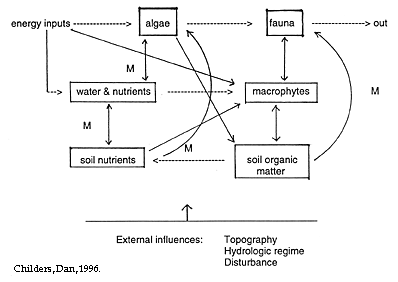
Title List
Related Sites
Home |
RESTORATION RESEARCH THEMES AND HYPOTHESES
Prepared by Robert F. Doren, Assistant Research Director, South Florida Natural Resources Center,
Everglades National Park, April 1, 1996.
The following concepts and questions about the research issues of HID restoration
were developed by the HID Technical Proposal Evaluation Committee and are provided
as a starting point for developing the framework research plan and program.
Do the newly created wetlands of the HID restoration project fall within the range of
natural wetland variability (structure and function) found within the Park? The
various method(s) available for making this kind of assessment have to be
explored. An important consideration is whether the proposed methodology
will allow us to answer the many research concerns and questions arising from the
restoration work.
One important factor in establishing research criteria is the permit requirement that the Park must
demonstrate successful mitigation, i.e., wetland restoration.
The requirements are spelled out in the permit under special conditions.
The flow diagram below, presented by Dan Childers, Florida International University,
establishes a foundation for understanding the interrelationships among biotic and abiotic components
within the HID ecosystem, specifically, and the
Everglades ecosystem, generally. Temporal and spatial relationships are not shown.
The symbol "M" indicates microbial activity. This diagram was used solely to assist
us in developing questions that did not inadvertently omit ecological elements.

HID RESTORATION CONCERNS AND RESEARCH QUESTIONS: A PRELIMINARY LIST
Structure and Function Interactions:
-
How are ecosystem structure and function related in newly created wetlands, and in oligotrophic Everglades wetlands in general?
-
How important is spatial variability/heterogeneity in understanding the
interaction of structure and function in newly created wetlands?
-
How does whole-system productivity and energy flow change as these newly
created wetlands develop?
-
Are plant community "differences", i.e., species composition, cover,
dominance, richness, etc., independent of function and state condition in newly created wetlands?
-
Are plant communities and associations structural representations of function and state variables in
newly created wetlands?
-
What is the desired wetland (and upland) structure and function for the restoration site?
-
How do the interactions of the biotic and abiotic factors, including disturbance,
determine the outcome of the restoration activity, and can the manipulation
of the abiotic or biotic elements of the area redirect the outcome in a particular
(favorable?) way for a particular outcome?
Exotic Plant Establishment:
Do nutrients control Brazilian pepper or is it a combination of water and nutrients?
-
What is the interaction between elevation, hydrology, and nutrients in
influencing survival and persistence of Brazilian pepper?
-
In its native habitat, what controls Brazilian pepper spread and vigor (pests,
diseases, browsers, etc.)?
-
Are native or newly created wetlands more or less invasible by exotic pest
plants, why, and what makes them so?
Restoration Alternatives:
Could the biological objectives of the restoration project be achieved without removing the
substrate?
-
What role does the hydrologic regime play in achieving the biological objective of
the restoration project? Can the hydrologic regime be controlled?
-
How does the chemistry of rock plowed substrate differ from "native" (unaltered) soil? Can the soil
characteristics/chemistry be changed?
Vegetation Dynamics and Succession:
What are the characteristics of successional velocity and trajectory
after soil removal and other major soil disturbances in newly created
wetlands?
-
Where do seeds come from during recolonization of newly created wetlands?
-
What determines change from an herbaceous to a wooded structure in newly
created wetlands?
-
How does the plant matrix affect the vegetation colonization pattern
in newly created wetlands?
-
How does soil (soil nutrients, soil organic content, bulk density, soil elevation,
etc.) develop in newly created wetlands, where there is no soil to begin with?
-
Is soil and/or water chemistry an adequate predictor of vegetation composition
in newly created wetlands? Is topography?
-
Are there any direct interactions between algae and macrophytes in newly
created wetlands?
-
How does a change in the soil nutrient regime influence community structure
in newly created wetlands?
-
How dynamic is the mosaic of habitats found in the Everglades? Specifically,
is there a predictable transition probability matrix among habitats (or, alternatively,
are they usually relatively stable across long time intervals)?
-
If there is any dynamic transition between habitats in the Everglades, is it
caused by fire, flood, drought, hurricanes, or other influences?
-
Does lack of soil in rockland systems determine macrophytic species composition?
-
Does lack of phosphorus in aquatic systems determine macrophytic and
microbial species composition?
Wildlife:
-
Are there threatened or endangered species that need to be accommodated in
the restoration site?
-
What animal populations may be displaced, reintroduced or enhanced
by the removal of Brazilian pepper from the restoration site?
|

